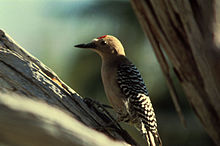Gila woodpecker
| Gila woodpecker | |
|---|---|

| |
| Scientific classification | |
| Domain: | Eukaryota |
| Kingdom: | Animalia |
| Phylum: | Chordata |
| Class: | Aves |
| Order: | Piciformes |
| Family: | Picidae |
| Genus: | Melanerpes |
| Species: | M. uropygialis
|
| Binomial name | |
| Melanerpes uropygialis (Baird, 1854)
| |

| |
| Distribution (green) | |
The Gila woodpecker (Melanerpes uropygialis) is a medium-sized woodpecker of the desert regions of the southwestern United States and western Mexico. In the U.S., they range through southeastern California, southern Nevada, Arizona, and New Mexico.
Description
[edit]
The back and wings of this bird are spotted and barred with a black and white zebra-like pattern. The neck, throat, belly and head are greyish-tan in color. The male has a small red cap on the top of the head. Females and juveniles are similar, but both lack the red cap of the adult male. White wing patches are prominent in flight. The dark tail has white bars on the central tail feathers. The birds range from 8–10 in (20–25 cm) in length.
This woodpecker's voice is a rolling churr sound. It also makes a yip yip yip sound and a kee-u, kee-u, kee-u sound. Its drum is long and steady.
Distribution & habitat
[edit]This woodpecker's habitat consists of low desert scrub typical of the Sonoran Desert, as well as arroyos (washes) and small towns.[2]
Behavior and ecology
[edit]Breeding
[edit]They build nests in holes made in saguaro cacti[3] or mesquite trees. Cavities excavated by these woodpeckers in saguaro cacti (known as a "boot"[4]) are later used by a variety of other species, including the elf owl.[5] There, they typically lay 3–4 white eggs, although as many as 6[6] or 7[7] have been noted. 2–3 broods are laid a year. Both sexes incubate and feed offspring.[6]
Feeding
[edit]As a woodpecker, its diet is composed greatly of insects, which it gains from drilling into bark.[7] Gila woodpeckers are omnivorous, and do take fruits, nectar, seeds, as well as lizards, eggs, worms, and even young chicks of small birds.[6] They are even known to hang on human placed hummingbird feeders and sip up the nectar.[4]
Status
[edit]The IUCN rates the species as least concern.[8] It is an endangered species in California, where populations have suffered notably. Arizona populations remain strong. The effects of climate change could severely reduce available habitat.[9]
Gallery
[edit]-
Female Gila Woodpecker, Paradise Valley, AZ
-
In Hermosillo, Sonora, Mexico
-
A Gila woodpecker drinking water
References
[edit]- ^ BirdLife International (2016). "Melanerpes uropygialis". IUCN Red List of Threatened Species. 2016: e.T22680853A92882402. doi:10.2305/IUCN.UK.2016-3.RLTS.T22680853A92882402.en. Retrieved 12 November 2021.
- ^ "Gila Woodpecker Overview, All About Birds, Cornell Lab of Ornithology". www.allaboutbirds.org. Retrieved 2020-12-30.
- ^ Elbroch, Mark; Marks, Eleanor Marie; Boretos, C. Diane (2001). Bird tracks and sign. Stackpole Books. p. 311. ISBN 0-8117-2696-7.
Cavities in saguaro cactuses in the Southwest are common. Both gilded flickers and Gila woodpeckers make these cavities for nesting, but they often choose different locations on the cactus.
- ^ a b "Gila Woodpecker Fact Sheet". www.desertmuseum.org. Retrieved 2019-02-22.
- ^ "Gila Woodpecker". Nature Conservancy. Archived from the original on 2016-12-15. Retrieved 2011-10-28.
Although they do not use them immediately, waiting first for the sap to harden, Gila Woodpeckers excavate cavities in cacti and trees as nesting sites.
- ^ a b c "Gila Woodpecker". Audubon. 2014-11-13. Retrieved 2019-02-22.
- ^ a b "Gila Woodpecker Life History, All About Birds, Cornell Lab of Ornithology". www.allaboutbirds.org. Retrieved 2019-02-22.
- ^ "The IUCN Red List of Threatened Species". IUCN Red List of Threatened Species. Retrieved 2019-02-22.
- ^ "Gila Woodpecker". The Audubon Birds & Climate Change Report. 2014-08-26. Retrieved 2019-02-22.
- Robbins, C.S., Bruun, B., Zim, H.S.; Birds of North America. New York: Western Publishing Company, Inc. (1966).
External links
[edit]- The Nature Conservancy's Species Profile: Gila Woodpecker
- This Woodpecker Will Drill Into Your Skull And Eat Your Brains—If You’re a Baby Dove
- "Gila woodpecker media". Internet Bird Collection.
- Gila woodpecker photo gallery at VIREO (Drexel University)
- Interactive range map of Melanerpes uropygialis at IUCN Red List maps
- IUCN Red List least concern species
- Melanerpes
- Endemic birds of Southwestern North America
- Fauna of the Sonoran Desert
- Native birds of the Southwestern United States
- Fauna of the Lower Colorado River Valley
- Fauna of the Yuma Desert
- Birds of Mexico
- Birds described in 1854
- Taxa named by Spencer Fullerton Baird





